Der Weg ist das Ziel!
Kreuzlingen / Konstanz (CH/DE) – Winner
TEAM DATA
Team Representative: David Vogel (DE) – architect
Merdingerstrasse 4, 79206 Breisach – Deutschland
+49 177 498 2102 – davidbvogel@googlemail.com
See the complete listing of portraits here
See the site page here

D. Vogel
INTERVIEW
1. How did you form the team for the competition?
I designed the project by myself.
2. How do you define the main issue of your project, insisting on how you answered on this session main topic: adaptability and urban rhythms?
At the beginning the task was to create a natural opening up. It was necessary to cross the barriers of the railway tracks such as the gap of national borders. That takes place with the "High Line", which gives access to the area without bridges or underpasses. It creates a direct connection between the centers of Konstanz and Kreuzlingen. Culture always works in the frontier zone, so a cultural building is designed in the center of the boundaries of railway tracks and Administrative boundary, which works as a gateway or as a valve to the other side. It defines the other side spatially, forces the transparency and the exchange. On the German territory it has a multifunctional theater and concert hall function; on the Swiss side, it is a museum and exhibition building. Between them is a common space, which demonstrates the importance of the complex for the two cities. It forms the hotspot for the exploitation of Klein Venedig. In the South of the Lago there is a building with 5 parking levels and 4 residential levels. In a further phase, the old shore is exposed again. This creates an island, which is designed as a park and acts as a recreational area. On the South of the border there is a new mixed-use district developed. Along the seafront there is an gastronomy, service and education area as well as on the higher floors residential developments. At the southern end there is a hotel as a conclusion of the site.
On the second line there are buildings with lake-oriented courtyards with areas for specialized housing and working zones in at the ground floor. All the apartments on both sides of the border will always have a view to the lake. At the North of the border there is a multi-functional plaza situated between the shore and the High Line. It also works as a plaza beyond the use of major events because of the restaurant and shops below the High Line.
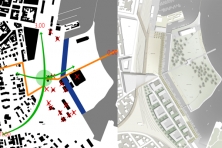
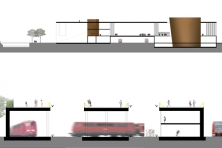
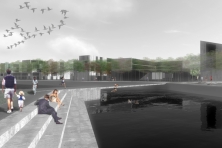
3. How did this issue and the questions raised by the site mutation meet?
It is a concept that breaks artificial barriers, combines nature and urbanity, and defines a common space. It offers the chance for an adaptable and sustainable urban development that will better connect both cities and the lake. It is not about infinity, it is about transparency. Without boundaries, there is no diversity - we can differentiate and exchange only with boundaries. This design does not force boundlessness, but the maximum permeability on the basis of common history, geography and topography.
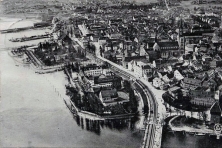
4. Have you already treated this issue previously and could you present some reference projects that inspired yours?
I studied architecture in Konstanz, so I have known the area for same years. I visited Brazil one year ago and was very impressed and inspired of the modern Brazilian architects such as Reidy, Mendes da Rocha or Lina Bo Bardi. But I also read some books about the history of Konstanz and Kreuzlingen, especially of the area of Klein Venedig.
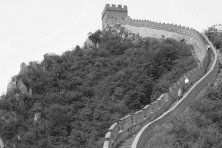

5. Today –within the era of an economic crisis and sustainability– the urban-architectural project should reconsider its production method in time; how did you integrate this issue in your project?
The main task is to solve the actual problems in the urban development concerning the public space, sustainability, adaptability for future developments and in this case the urban rhythms and connections between Switzerland and Germany -Konstanz and Kreuzlingen. I tried to combine these points to get the maximum quality and atmosphere with minimal expenses.
6. Is it the first time you have been awarded a prize at Europan? How could this help you in your professional career?
Yes, it was my first Europan prize. I think it will help me establish an architectural and urban design practice in the future.